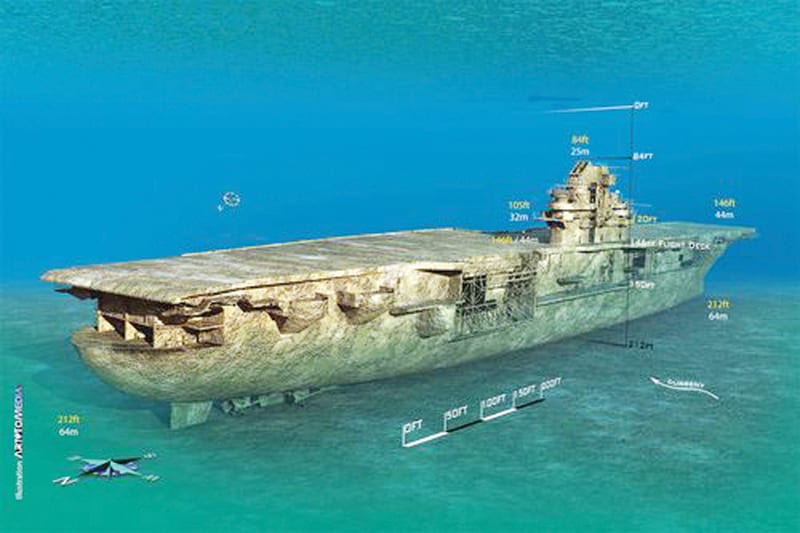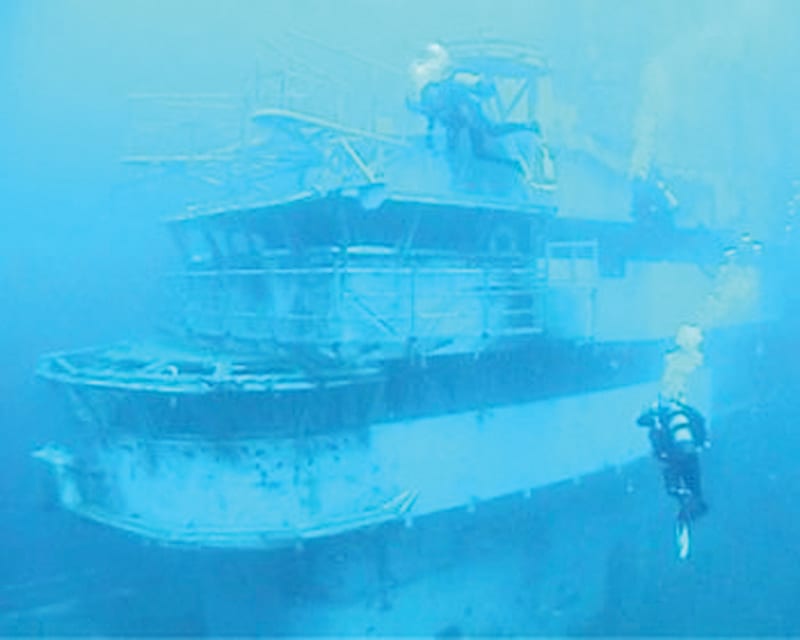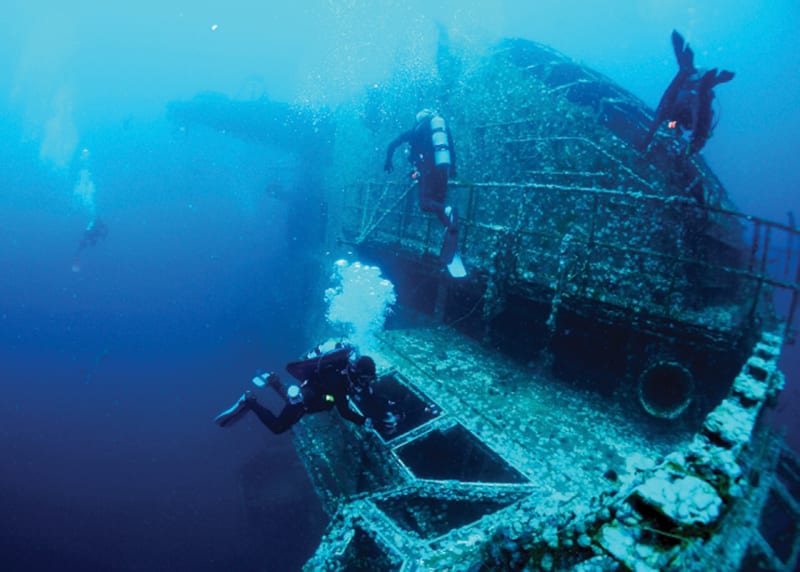By: Kevin Freeland / Dive Pros
With the fairly recent discovery of the HMS Hermmes off of Sri Lanka, there are now three divable aircraft carriers in the world. But first you have to get to Sri Lanka. There is the USS Saratoga in Bikini Atoll. This ship is way out in the south Pacific. Then you have the USS Oriskany right here in the northern Gulf of Mexico, just south of Pensacola Florida. The Oriskany truly is a “bucket list” dive. Sitting upright on the bottom at almost 14 stories high, 150 feet wide, and nearly 900 feet long, the Oriskany has been billed as the world’s largest artificial reef. It is massive. I knew even before she went down that the sheer size of the wreck would lend itself to being its own ecosystem. And I was right. The wreck was immediately populated with bottom dwelling and reef fish. It wasn’t long before the pelagics found her. It is not uncommon to see whale sharks and manta rays on the Oriskany. She sits in 212 feet of water about 23 miles south of Pensacola. This site was chosen to maintain the 65 feet of clearance needed above the wreck. The depth of the wreck created some controversy as many wanted it to be shallower. The superstructure was prepped for divers. The vast majority of insulation and wiring were removed so as not to create entanglement hazards. Many doorways were welded open, and some additional egress points were cut into many of the rooms of the superstructure, in an effort to make the superstructure safer for divers. Below the flight deck these precautions were not feasible as the hull is 900 feet long. We treat the wreck as you would a wall in the Caribbean. Bottomless diving, unless trained and equipped you just don’t go to the bottom. I believe the depth of the wreck has been a deterrent to many penetrating the wreck and no doubt has saved some lives. The hangar bay doors are a mere 30 feet beyond the flight deck, but as you look into this massive, square, cave like maw of an opening that beckons you into the interior of the hull, you realize you are at 175 feet under the ocean on your single outlet aluminum eighty, and it is probably not a good idea to go inside.
I have personally dived on the Oriskany over sixty times and it never gets old. We were there when she was sunk, which was supposed to take several hours. We took out lunch and a blow up mattress floaty to lounge on in the water while we waited. The charges were detonated and 45 minutes later she was on the bottom. We were not allowed to dive her that day as the Navy demolition crew had work to do securing their equipment and such. The next day we arrived early in the morning and joined a boat that was already trolling around the wreck for a bite. We drug the anchor across the deck and got hooked in. Not expecting to see a single fish we were armed with cameras and not spearguns. I was one of the first to approach the top of the structure and as I did I was greeted by a large red snapper, all I could think of is, what are you doing here? A few weeks later we went back, as I approached the deck I noticed scallops, everywhere, every horizontal surface was covered in these little bivalves. As you got near them they all took off, jetting about as if they had somewhere to be. It was amazing.
As you drift down the thin line mooring the dive boat to the Oriskany, the first thing to come into view is usually the distinct grated covering of the smoke stack. You follow it forward to a rectangular antennae platform and on the starboard side hanging from the signal yardarm you will see an American flag above a POW/MIA flag, and they are both swaying in the current. From there you descend down to the pilot house canopy where you peer into the odd shaped windows of the pilot house of the vessel. If you penetrate here you can follow a stairwell down to the next level or the flag bridge where you have an unobstructed view out the windows to the flight deck down below. Swim outside these windows and continue to circumnavigate the superstructure. As you swim along pay attention for the mementos left by other divers. There is a sculpture of a sea turtle, a fireman’s helmet, a ship’s bell and numerous caches of offerings to King Neptune. That in itself is one of the amazing things about this wreck. For nearly thirty years I have been diving wrecks here and the order of the day was to find and remove souvenirs from them. The Oriskany inspires people to leave things here. A dear friend of mine has interned the ashes of both his mother and his father in concrete hearts, and placed them on the flight deck. One of the most memorable dives was such a memorial dive where five of us went to the Oriskany to bring a good friend’s Edge dive computer to the site, as he passed away before he could dive her. It was a full moon and we had planned a night dive. We would take Ray’s Edge, turn it on and drop it down the smokestack. We all got in the water and everything went as planned. We watched Ray’s computer vanish down the stack, finally he gets to dive her. After about twenty minutes we all, one by one, turned off our dive lights. The full moon gave us plenty of illumination to where we could make each other out by our silhouettes and by the bioluminescence from our swimming and our exhaust bubbles. It was surreal, but no one turned their lights back on. We spent the next twenty minutes or so enjoying each other’s company, the company of the Oriskany, and the company of Ray, in the dark. It was one of my best dives ever.
Over time the wreck has covered with growth and all sorts of critters have moved in. She is home to several resident groupers including at least one Goliath. You will commonly see Red Snapper, Amberjack, and a myriad of baitfish.
Probably the biggest challenge for recreational divers, aside from managing their depth, is managing air consumption. The visibility is usually from 60 to 100 foot plus on the Oriskany so it is easy to exceed your planned depth. The flight deck is at 145’ and it seems everyone wants to go there. Anytime you dive to these depths gas management is imperative. The wreck is easy to navigate as we suggest people not leave the superstructure.
The challenge for tech divers is similar to those for rec divers as there is just so much to see they don’t want to leave. Aside from that issue probably the biggest challenge is penetration of the hangar bays. These spaces were not cleaned of insulation and wiring so there are many entanglement opportunities inside the hull. Exhaust bubbles alone are enough to loosen rust from the ceiling and create a silt-out. Lines are a must.
All divers who visit the Oriskany should have a surface marker buoy. There is usually a steady current on the site and should you get away from the mooring line on ascent you want to be seen by the boat when you surface.
Probably the most common reaction for first time Oriskany divers is one of awe. Most have never been on a wreck so large, with so much to see.
For more information or to plan a dive on “The Big O”, please call Dive Pros: #850-456-8845 or view our ad on the next page.
Dive Pros
7203 West Highway 98 * Pensacola FL 32507
Phone: (850) 456-8845 * Fax: (850) 456-0025
florida-divepros.com



